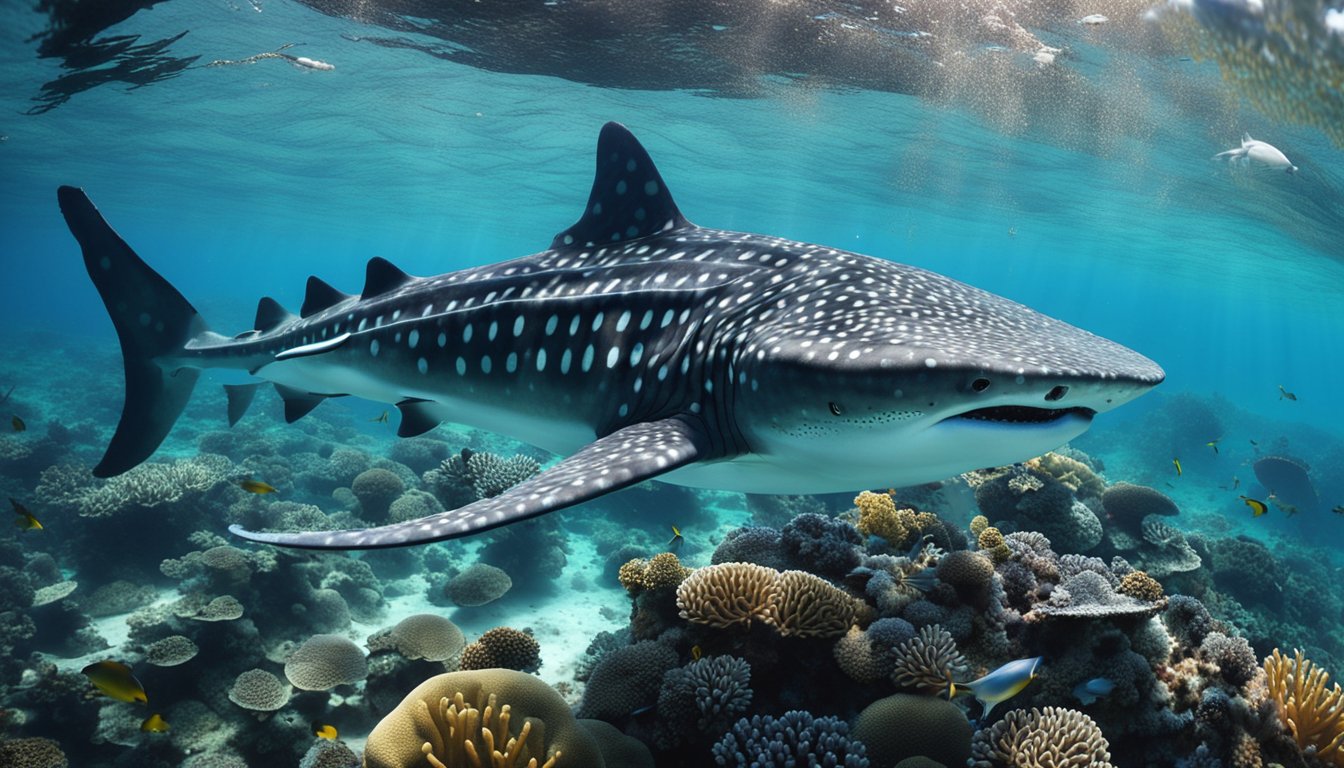Whale sharks are the largest fish in the ocean, but despite their size, they are gentle giants.
These magnificent creatures can grow up to 40 feet long and weigh as much as 20 tons.
They are known for their unique pattern of spots and stripes, which are as distinctive as a human fingerprint.

Despite their impressive size, whale sharks are not aggressive towards humans.
In fact, they are known to be quite docile and often swim alongside divers without any sign of aggression.
They are filter feeders, which means they feed on plankton and small fish that they filter from the water using their gills.
Whale sharks are found in all tropical and warm-temperate waters around the world, but they are most commonly found in the Indian and Pacific Oceans.
They are a migratory species and follow the plankton blooms that occur in different parts of the ocean.
Despite their widespread distribution, much of their behavior and life cycle remains a mystery.
In this article, we will explore the mysterious lives of these gentle giants and learn more about their fascinating world.
The Whale Shark: An Oceanic Marvel
Defining the Whale Shark
The whale shark, Rhincodon typus, is the largest fish in the world. It is a filter-feeding shark that feeds on plankton and small fish.
The whale shark is not a whale, but it is named after whales due to its huge size.
It belongs to the family Rhincodontidae, and it is the only member of its genus.
The whale shark is found in open waters of tropical oceans and is known to migrate long distances.
Physical Characteristics
The whale shark has a distinctive appearance with its huge size, flattened head, and wide mouth. It can grow up to 40 feet long and weigh up to 20 tons.
Its mouth can open up to 4 feet wide, and it has over 300 rows of tiny teeth.
Despite its size, the whale shark is harmless to humans as it feeds on plankton and small fish.
The skin of the whale shark is covered in white spots and stripes, which are unique to each individual, like a fingerprint.
These patterns can be used to identify and track individual whale sharks.
The skin is also very thick, up to 10 centimeters, which provides protection against predators and parasites.
The whale shark is a fascinating creature that continues to amaze scientists and researchers.
Its mysterious life and behavior are still being studied, and there is much to learn about this gentle giant of the ocean.
Habitats and Migration Patterns

Global Distribution
Whale sharks are found in all tropical and warm-temperate seas around the world.
They inhabit coastal and offshore waters, including coral reefs, lagoons, and open ocean.
These gentle giants can be found in waters as shallow as 10 feet and as deep as 6,150 feet.
The largest concentration of whale sharks is found in the Indo-Pacific region, particularly in the waters of the Philippines, Indonesia, and the Maldives.
In the Atlantic Ocean, they are commonly seen in the waters of the Gulf of Mexico, the Caribbean, and the western coast of Africa.
Migratory Behaviors
Whale sharks are known to undertake long-distance migrations, but their exact migration patterns are still not fully understood.
Some studies suggest that they follow ocean currents and seasonal changes in water temperature and food availability.
During the summer months, whale sharks can be found in the northern hemisphere, including the Gulf of Mexico and the Sea of Cortez.
In the winter, they migrate to warmer waters in the southern hemisphere, such as the waters of Australia, Mozambique, and the Seychelles.
Whale sharks are also known to gather in certain areas at specific times of the year for feeding, such as the waters off the coast of Mexico’s Yucatan Peninsula, where they congregate to feed on plankton.
Despite their large size and migratory behavior, whale sharks are not considered pelagic animals, as they tend to stay near the surface and are often found in the vicinity of land masses.
Fun Fact: Whale sharks have been known to travel up to 8,000 miles in a single year.
Diet and Feeding Habits

Whale sharks are known as filter feeders, which means they consume tiny organisms such as plankton, krill, and small fish by filtering them out of the water.
Their feeding mechanisms and dietary preferences are fascinating and unique.
Feeding Mechanisms
Whale sharks have a unique feeding mechanism that allows them to consume large amounts of food without expending much energy.
They use a process called cross-flow filtration, where they open their massive mouths and swim forward, allowing water to flow in and out through their gill rakers.
The gill rakers act like a sieve, trapping the food while the water flows out through the gills.
This process allows them to consume up to 1,500 gallons of water per hour.
Dietary Preferences
Whale sharks have a diverse diet that includes a variety of small organisms.
They primarily feed on plankton, but they also eat krill, small fish, and squid.
Despite their massive size, they have small teeth that are not used for chewing but rather to grip their prey.
They swallow their food whole, and their digestive system breaks down the food.
Interestingly, whale sharks are known to migrate to areas where there is an abundance of food.
They follow the blooming of plankton and other small organisms to feed.
They are also known to feed near the surface during the day and dive deeper at night to feed on deeper-dwelling organisms.
Whale sharks play a crucial role in maintaining the ocean’s ecosystem by consuming large amounts of small organisms.
They are gentle giants that are fascinating to observe in their natural habitat.
Conservation and Human Interactions

Threats to Whale Sharks
Whale sharks are listed as vulnerable by the International Union for Conservation of Nature (IUCN) due to the numerous threats they face.
One of the biggest threats to whale sharks is commercial fishing.
Despite being protected in many countries, whale sharks are still hunted for their meat and fins, which are considered a delicacy in some parts of the world.
Additionally, they are often accidentally caught in fishing nets, which can lead to serious injury or death.
Another major threat to whale sharks is habitat destruction.
As coastal areas become more developed, their natural habitats are destroyed, leaving them with fewer places to feed and breed.
Pollution is also a significant issue, as it can cause harm to the whale shark’s food sources and lead to health problems.
Conservation Efforts
Fortunately, there are many conservation efforts underway to protect whale sharks.
Many countries have implemented laws to protect them, and there are also international agreements in place to regulate their trade and protect their habitats.
In addition, many organizations are working to raise awareness about the importance of whale sharks and their conservation.
One such organization is the Whale Shark and Oceanic Research Center (WSORC).
They conduct research on whale sharks and their habitats, as well as work to educate the public about the importance of conservation.
Another organization, the Marine Megafauna Foundation, works to protect all types of marine megafauna, including whale sharks, through research, education, and conservation efforts.
Overall, it is important to remember that the conservation of whale sharks is not just important for the survival of this gentle giant, but also for the health of our oceans and the many other species that call it home.
Frequently Asked Questions

What habitats do whale sharks prefer around the world?
Whale sharks are found in all of the world’s tropical and warm-temperate seas, from the Equator to about 30 degrees latitude.
They are known to inhabit the open ocean, near the surface, and are often seen in areas where plankton is abundant.
They can also be found in coastal waters near coral reefs and estuaries.
How do whale sharks compare in size to the enormous blue whales?
Whale sharks are the largest fish in the world, but they are not as large as the blue whale, which is the largest animal on earth.
The average size of a whale shark is around 40 feet (12 meters) long, while the average size of a blue whale is around 100 feet (30 meters) long.
Can you share some intriguing behaviors of whale sharks?
Whale sharks are known for their gentle nature and are not dangerous to humans.
They are filter feeders, which means they swim with their mouths open to scoop up plankton and small fish.
They can also be seen swimming near the surface with their dorsal fins breaking the water, a behavior known as “finning.”
What are the conservation efforts in place to protect whale sharks?
Whale sharks are listed as a vulnerable species by the International Union for Conservation of Nature (IUCN).
Many countries have laws in place to protect them, and there are also international agreements to regulate their trade and protect their habitats.
Some organizations are working to raise awareness about the importance of whale sharks and their conservation.
What role do whale sharks play in ocean ecosystems?
Whale sharks are important to the ocean ecosystem because they help regulate the population of plankton and small fish.
They are also a source of food for larger predators such as sharks and killer whales.
Additionally, they are an important attraction for ecotourism, which can bring economic benefits to local communities.
How do local legends and folklore portray whale sharks?
In some cultures, whale sharks are seen as a symbol of good luck and prosperity.
In the Philippines, they are known as “butanding” and are considered sacred in some areas.
In other cultures, they are seen as a threat to fishermen and their catch.
Overall, whale sharks have been a part of human culture for centuries and continue to fascinate people around the world.









